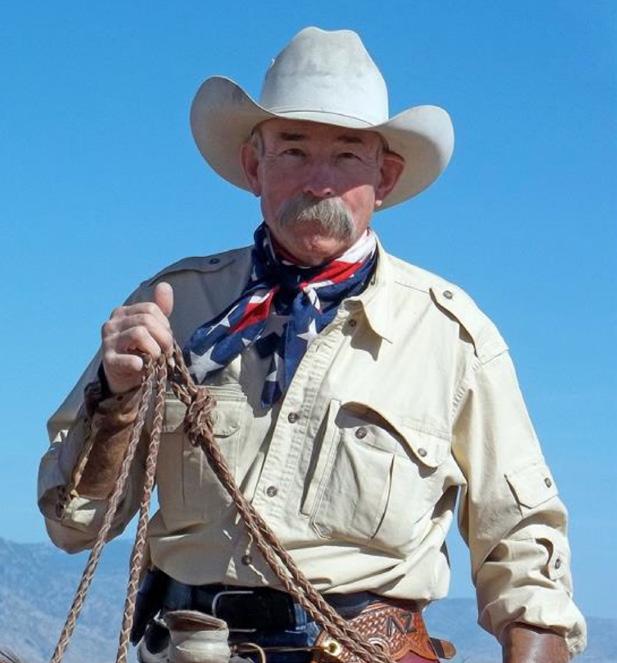
34 minute read
On the Edge of Common Sense: Baxter Black
On the Edge of Common Sense
with Baxter Black
Religious Reflections
I was sittin’ in the back row of a beautiful little church in a mountain town in the Rockies. I was there for the wedding of a daughter of good friends.
As the service progressed, my attention was drawn to a banner that hung on the wall. It was handmade, cut from cloth and intended to be inspiring. It read, Mount Up With Winos.
Many thoughts went through my mind as I tried to absorb the full meaning of this elaborate banner. I had come to realize over the years that many Protestant churches have become more liberal in their teachings. Acceptance of alternative lifestyles, less moral browbeating, less blatant emphasis on money, more convenient schedules and greater tolerance of lesser sins; i.e. fall football, alcohol, sex and non-Christian religions.
And there is something to be said for that religious creed. After all, Jesus himself never discriminated.
Bein’ a thinker myself, I began to concoct other potential banner slogans that might be acceptable in this New Age congregation; Ride with the Risque, Sail with Sinners, Lie Down with the Licentious, Commune with the Immoral, Huddle with the Homeless, Do Lunch with the Offender.
The wedding audience was mostly ranch people, men with sunburned faces wearin’ new jeans and uncomfortable in their ties. The women wore their best dresses and the kids were glad to be anywhere off the ranch. We all squirmed quietly in our pews as the preacher read the vows, told them marriage was forever and lent dignity and tradition to what we all hoped would be a union made in Heaven. We were happy for the parents and appreciated the page turning in their life. We’d all been there or soon would be.
I’d come with my family to pay tribute to the parents... my friends. But I admit my distraction with the banner had consumed a good part of my attention during the service. I began to think that it was inappropriate.
When the soloist rose and sang the final George Strait love song while the bride and groom escaped, she was positioned right below the banner. Poor planning, I thought, or at least in poor taste.
As we were filing out I asked my daughter what she thought of the banner.
“Which one?” she asked.
“The one right above the singer,” I answered.
She studied it and read aloud, “Mount up with Wings. Kinda cool, I guess. Why?”
“Oh,” I said, vowing silently to start wearing my glasses more often, “Just curious.”
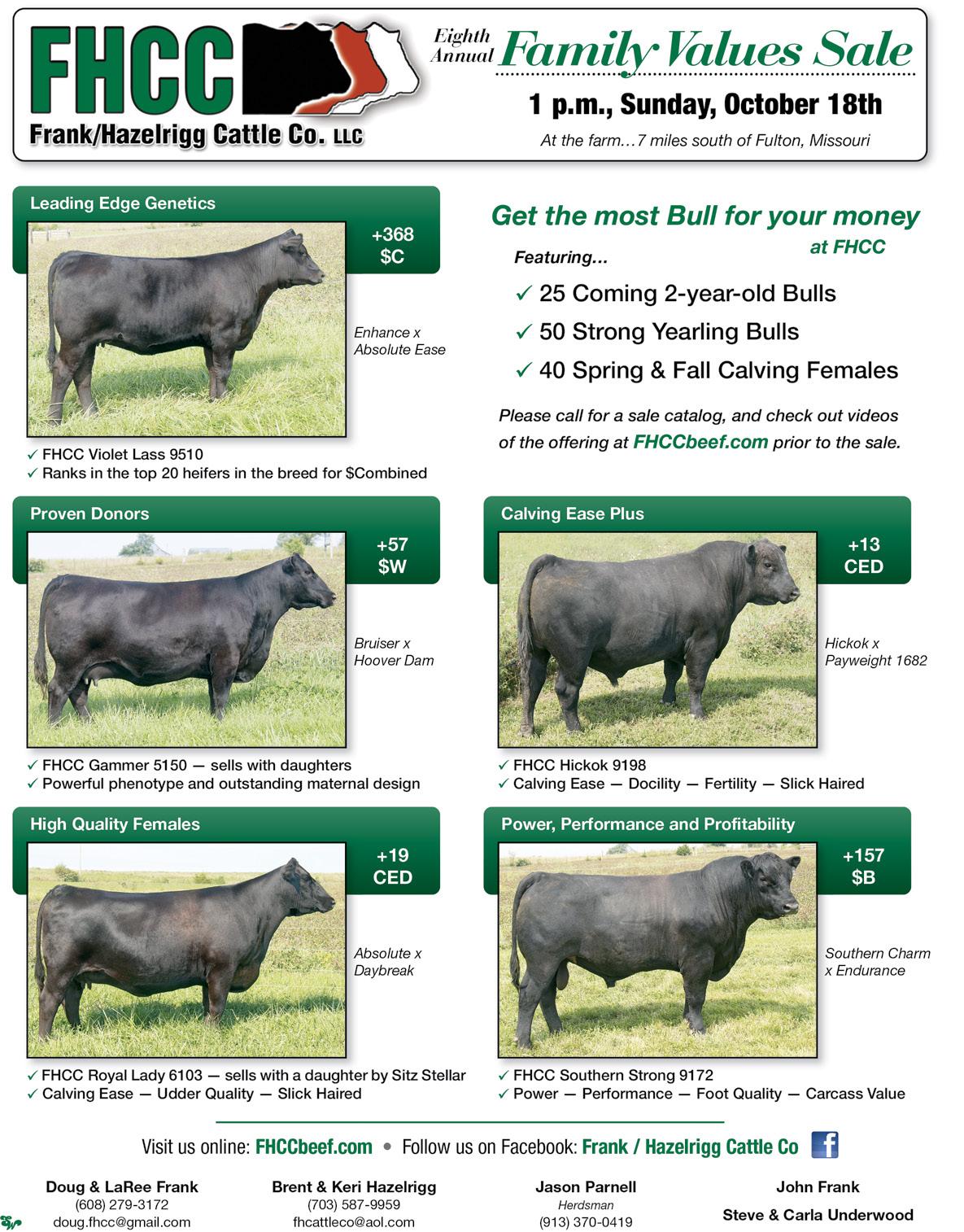
Source: CAB - Kylee Kohls
“Meat heads” by education and experience, scientists and number crunchers gather to analyze the latest scatter plot. Coffee fuels the banter as they discuss where the figures point toward progress.
It’s Friday morning: analysis day for the Certified Angus Beef ® (CAB®) brand packing team.
Meat scientist Daniel Clark brings a new scatter plot each week, along with a fresh perspective to answer last week’s questions. More than 2.6 million points fill the screen, each dot measuring how carcasses meet the 10 brand quality specifications — providing insight for possible improvement. How could adjustments help a premium supply meet the growing demand? Changes don’t happen overnight. The brand’s integrity is tied to these specifications, so they don’t evolve without careful consideration. “The first question we ask,” Clark says, “is how it will affect our partners up and down the supply chain.”
Beyond the grading stand
On September 9, 2020, CAB will implement two changes to its “G1 schedule” specifications. The first, a subtle rewording, adjusts the fat thickness limit from “less than 1 inch” to read “1 inch or less.” It might sound the same, but that precise language allows USDA graders more accurate measurements. Camera grading calculates fat thickness to several decimal places and that provides consistency and clarity when dealing with fractions of an inch. The second change allows packers with an “extended licensing agreement” to box beef from some primals that met all quality specifications, but exceed the ribeye area, up to 19-square inches. Ribs, ribeyes, strip loins and short loins from these carcasses will be excluded from the brand. “This is not an expansion of the ribeye area to 19-square inches, but rather capitalizing on other parts of the carcass that are practically unaffected by that limit,” says Clint Walenciak, CAB director of packing. access CAB briskets, tenderloins, short ribs and end meats for roasts and ground beef from those carcasses that fall in the 16- to 19-square include ribeye. The exclusion of larger ribeyes, ribs, strip and short loins, maintains brand-quality plate presentations and thicker cuts for the key middle-meat items. Box quality, consistency and center-of-the-plate steak presentation standards remain the same.
“I don’t want to overstate the magnitude of the expanded specification, but it is one small step in one big direction,” Clark says. “This is exciting for the future of
the brand and for our partners on all fronts.” Their research shows the size differentiation of cuts entering the box from the carcasses with a larger ribeye will have little to no impact on the size or weight of the box.
“The expanded product specification is voluntary for packers, and may be incorporated when timing is right to satisfy customer demand on a plant-by-plant basis,” Walenciak says.
Until a packer implements this change, its impact on premiums and discounts is uncertain.
Cattlemen should not take their eye off of ribeye size, Walenciak says. While this innovation creates potential access to additional high-quality cattle, demand pressure for 10 to 16 square-inch ribeyes remains.
Next Friday, the packing team will evaluate data again, searching for new clues on how to make the best even better.
It’s a team effort to crunch the numbers, balance the science and calculate the scope of possible adjustments. Never sacrificing quality, the ongoing process can evolve the specifications if that raises the standard, says Bruce Cobb, CAB executive vice president of production.
“Making those cattle more valuable, these specification expansions help the brand gain strength and footprint on the market path to two billion pounds of supply annually,” he says.
The focus remains on fulfilling demand and creating economic incentives for cattlemen and all supply chain partners.
“We are working toward a vision where this brand supplies more of the best that Angus cattlemen create,”

Progress is a process that happens one dataset, conversation and cup of coffee at a time.
The 10 Science-based Specifications:
To earn the Certified Angus Beef ® logo, Angusinfluenced cattle with a predominantly solid black coat must pass its 10 quality standards:
Marbling
1. Modest or higher marbling – the single largest barrier to CAB acceptance, this ensures superior flavor and juiciness. 2. Medium or fine marbling texture – many small flecks of fat as opposed to larger, coarser characteristics.
Creates consistency in every bite.
Maturity
3. 30 months of age or younger – ensures superior color, texture and tenderness
Consistent sizing
Three specifications ensure thicker steaks and consistent plate presentations: 4. 10- to 16-square-inch ribeye area* 5. 1,050-pound or less hot carcass weight 6. 1 inch or less fat thickness
Plate presentation
7. Superior muscling limits light-muscled cattle – reduces influence of dairy-type cattle with inconsistent yields and plate presentation
Quality appearance and tenderness
8. Practically free of capillary rupture – ensures quality appearance 9. No dark cutters – ensures consistent appearance and flavor 10. No neck hump exceeding 2 inches – safeguards against Brahman-influence cattle, which have more variation in tenderness
*Up to 19 square inches for ribeye area is acceptable for tenderloin, brisket, thin meat, chuck and round cuts at approved plants. Rib, ribeye, strip loin and short loin are excluded from this option.
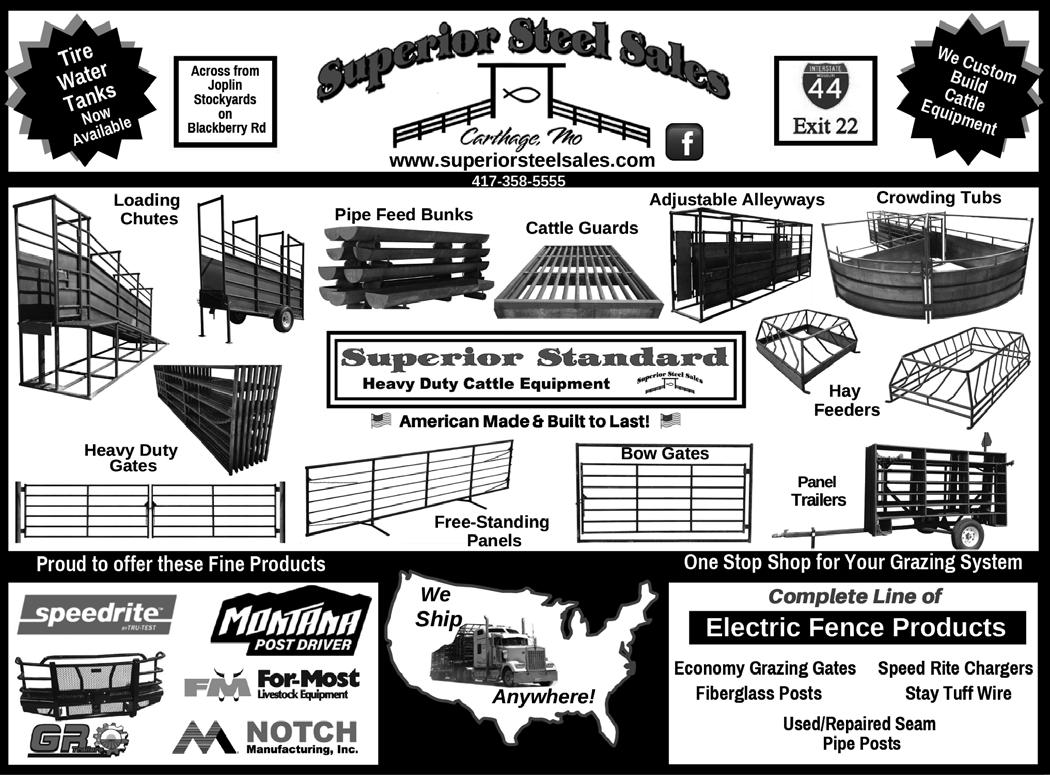
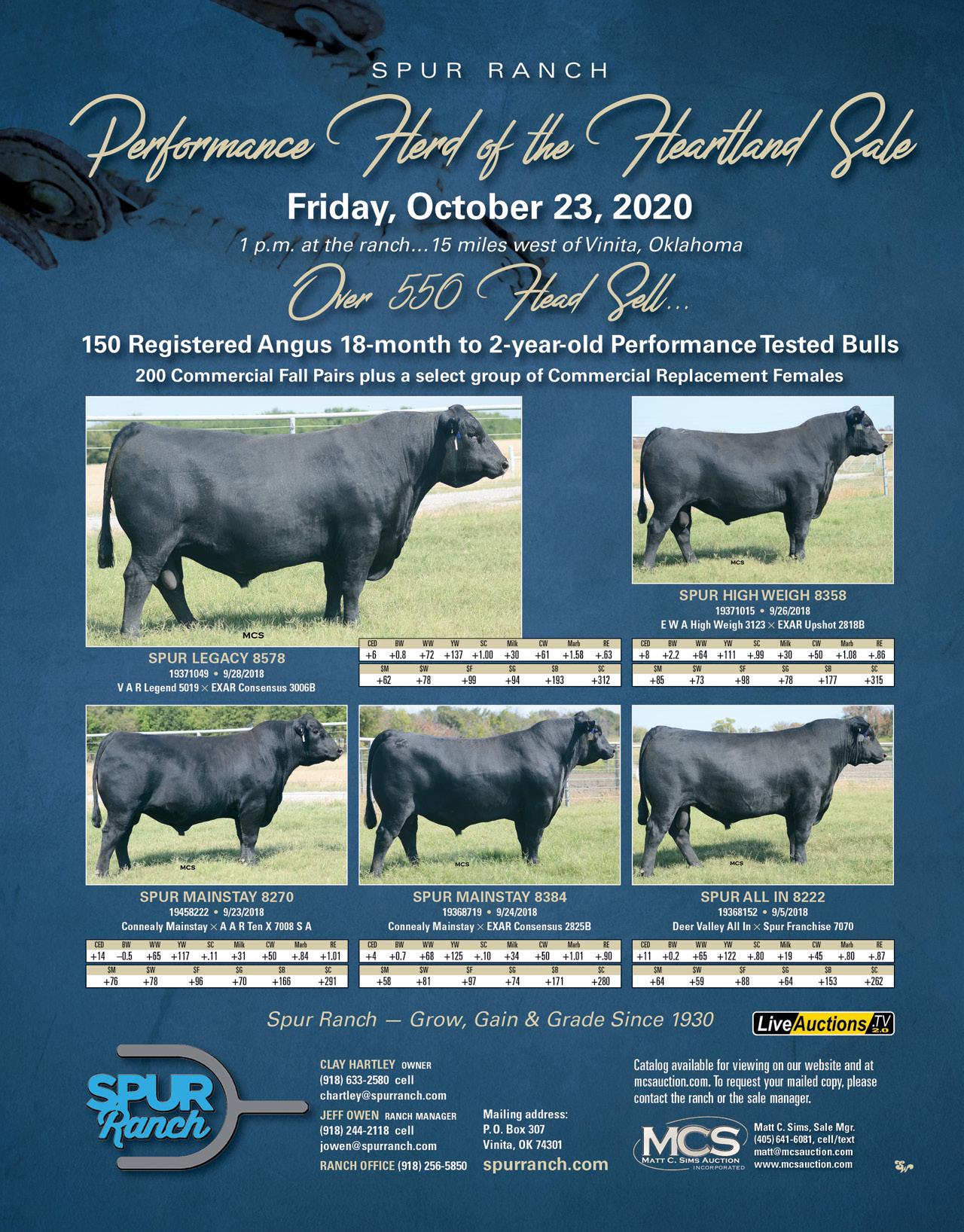
Source: CAB - Miranda Reiman
Demand drivers.
Even without a worldwide pandemic, economic shutdowns and disruptions in food processing, Dan Basse would have covered demand drivers at the 15th annual Feeding Quality Forum.
The president of Chicago-based AgResource Company had charts to back up his point: “Going back maybe to the Civil War, it’s those demand drivers that give opportunity to the market.” Basse kicked off the on-line forum hosted by the Certified Angus Beef ® brand last month.
Grain markets typically lead market direction. Supply is no problem, with a 2.7% increase in global grain yields in the last decade compared to the previous.
“There’s been $87 billion spent looking for technology for farmers to help produce more—more beef, more pork, more grain,” Basse said. “I would really like to get agriculture behind a platform that we think about not only spending on ways to help us farmers produce more, but help consumers consume more, because as the end of the day, that will be the key to terms of our profitability.”
This year, however, those demand drivers are even more lackluster than anyone could have predicted at the start of 2020.
More than 3 million small businesses have shut down since COVID-19 came to the U.S. and that could reach 6 to 8 million by the end of the year.
“It’s the heart of the U.S. agricultural and economic outlook,” he said. Last year was the first time more Americans—51% of them—spent most of their food dollar outside the home, “so it’s a big change to have that [food service] industry crippled as it is,” he said.
Restaurants are operating at about 40% of normal, and it could be a year or more before they’re back to 100%, Basse said, noting the development of a vaccine or a strong therapeutic seems to be the key.
“The food service industry has been very important to the U.S. cattle industry. We’re still believing that it will struggle until we get to next spring,” he said. “I wish I could be more bullish in the cattle market.”
Kingsville Livestock Auction Kingsville, Missouri Hwy. 58 • 45 Miles SE of Kansas City, MO Special Cow & Bull Sale Saturday, October 24 • 11:00 a.m. Cattle Sale Every Tuesday 10:00 a.m. For information call Rick or Jeremy Anstine 816-597-3331 or 816-732-6070 Visit our Website at: www.anstineauctions.com or E-mail us at: kingsville@earthlink.net
Trade is not in the domestic beef industry’s favor either, as the U.S. has been importing more food than it’s been exporting the last four months. Beef industry exports are down 15.2%.
“To really get health in the agricultural economy, we need to start the export market kicking off a little more robustly. We need to see high-value goods leaving this country to other nations,” Basse said. “Principally beef, meats and some of the DDGs and ethanol products we now produce.”
(Continued on page 62)

Missouri Angus Breeders The #1 State For Angus!
The Pipkin Family 9770 W. State Hwy 266 • Springfield, MO 65802 j_pipkin@sbcglobal.net • clearwaterangus.com Jim (cell) 417-827-0623 • Joann (cell) 417-827-2756 WD & Bonita Bulls • Replacement Females for Sale
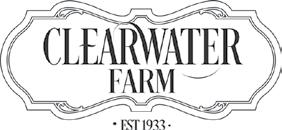
GERLOFF FARMS
Connealy Power Surge AHIR Bulls Semen Available
Females 3154 Hwy A Bland, MO 65014
Dedicated to 573-437-3751/2507 Charlie Cell: 573-680-9117 the Livestock Kim Cell: 573-291-1091 Industry Since 1906 khuebler@fidnet.com www.gerloffcattle.com
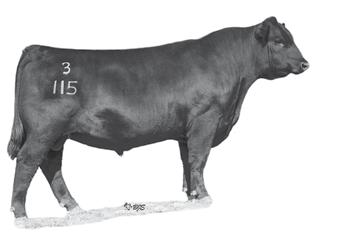
For All Your Angus Needs!
October 19 Fall Sale
Kenny & Janyce Hinkle 14103 E. Summers Rd. • Nevada, MO 64773 Ph/Fax: 417-944-2219 • Cell: 417-448-4127 E-mail: hpca@centurytel.net Bulls are our Business!
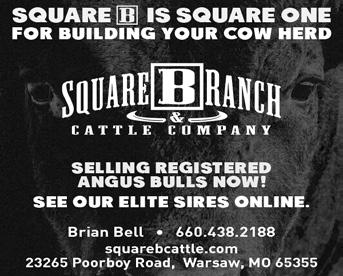
Russel and Randy Miller 21146 400th Street Graham, MO 64455 660-254-0137 • 660-415-6339 E-mail: galaxybeef@hotmail.com
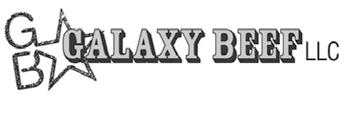
WEIKER Angus Ranch 660-248-3640 Fred Weiker • Julia Weiker Fred: 660-248-3765 1339 Hwy 124, • Fayette, MO 65248 “Where the Extraordinary are Availible”

22227 Saline 127 Hwy • Malta Bend, Mo 65359 Brian Marshall • (660) 641-4522 www.marshallandfennerfarms.com
Since 1942
October 24 Fall Production Sale
21658 Quarry Lane • Barnett, MO 65011 Office: 573-302-7011 • Fax: 573-348-8325 E-mail: meadangus@yahoo.com Website: www.meadfarms.com Alan Mead, Owner 573-216-0210
Bull and Female Sale October 14
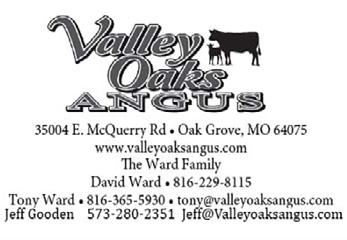
Eighth Annual Family Values Sale 1 p.m. Sunday, October 18 At the farm 7 miles south of Fulton, MO Doug & LaRee Frank 608-279-3172 Brent & Keri Hazelrigg 703-587-9959 Visit us online: FHCCbeef.com Bulls Always for Sale, at the Farm.
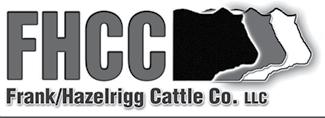
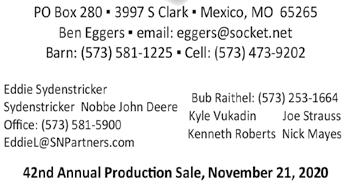
CIRCLE A RANCH 41 Hwy K Iberia, MO 65486 1-800-CIRCLE-A
Dave Gust, Sr. Dave Gust, Jr. Nick Hammett, Commercial Mktg. Mike Lembke Kevin Lennon
Julie Conover, Gen. Manager 634 S.W. 1201 Rd • Holden, MO 64040 734-260-8635 E-mail: Julie@missouriangus.org missouriangus.org
334 Seth St. - Lincoln, MO 65338 www.RichardsonRanch.net adrrmd@mail.missouri.edu
Registered Angus Bulls & Females Available
Pete Ashlyn 660-281-0353 660-281-1720 Russell & Susan Coon 1318 Shelby 169, Bethel, MO 63434 660-284-6518 h • 660-341-2705 c ruscatsol@gmail.com Larry Coon 1284 Shelby 169, Bethel, MO 63434 660-284-6473 h • 660-342-3889 c

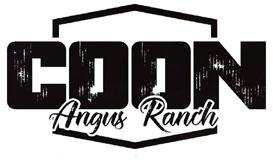
He suggested Live Cattle futures are overvalued, and cattlemen should consider hedging at $112 to $114 during the last quarter of 2020, and at $116 to $118 into the first part of 2021.
“There is some risk in feed prices based on the lateseason dryness, Chinese demand and things of that nature, but also based on the broad commodity markets, which are starting to turn around here just a little bit,” Basse said. Following the Midwest derecho storm, AgResource predicted yields to slip from record highs, down to around 179 bushels/acre, which is still nearly “on trend.”
Yet, he expects the lows to come later this fall.
“Don’t get bullish and chase this market as a feed user today. Step back and allow the market to come to you in October and November,” he advised.
Economic wild cards include political outcomes and continued stimulus measures.
“Never before did I think we’d see a U.S. debt level for government at $26.8 trillion and still growing,” Basse said. “These debt levels are something that I believe will Growth across the globe has slowed, too, but India and China are still expected to become the No. 1 and 2 largest economies, overtaking the U.S. by 2025 or 2026.
Government support plays a big role in overall farm income, accounting for 40% to 45% of net farm revenue this year.
“That is something I never thought I would see in my career,” said the 41-year veteran.
Net farm income is down 47% from 2012, and has been flat for a number of years.
Basse looks each morning for signs of everything from new export demand to product innovations. “We need to see a new demand driver for you to get this all changed around,” he said.
Feeding Quality Forum sponsors include Diamond V, Feed-Lot Magazine, Micronutrients, Zoetis and AngusLink. For more information or to watch full presentations, visit www.FeedingQualityForum.com.
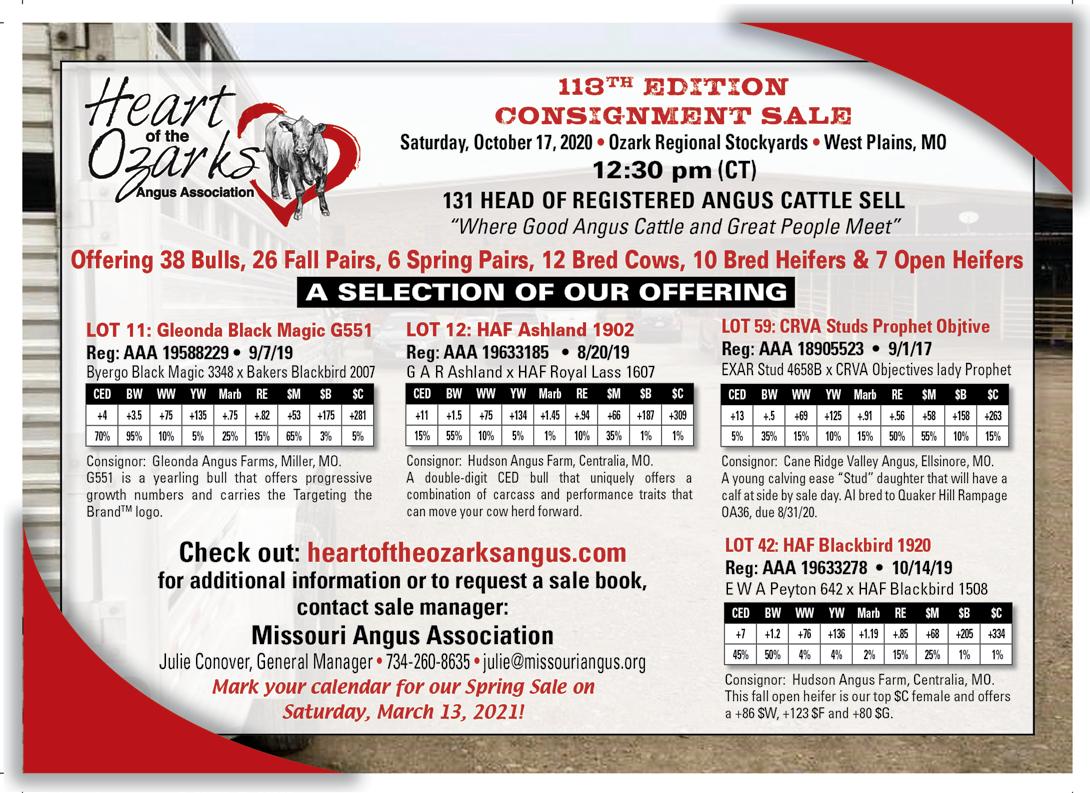
Top Dollar Angus Announces Search for New General Manager
Source: Top Dollar Angus
Denver – Top Dollar Angus, Inc. is in search of a new general manager, following the departure of Jared Wareham of Deepwater, Missouri. Wareham’s tenure saw the business grow at a rate greater than 60% annually. “Jared greatly enhanced industry awareness of the Top Dollar Angus brand, and helped producers in all segments of the beef business understand the value of genetic verification at the feeder calf level of the market,” said Tom Brink, CEO of the Red Angus Association of America and founder of Top Dollar Angus. “He traveled extensively from coast-to-coast and established relationships that will continue for years to come, while also shaping our strategy in multiple ways. Top Dollar Angus is much closer to being a household name among cattle producers in large part due to Jared’s efforts and networking ability. We appreciate everything he did and wish him and his family the best in the new employment opportunity he plans to pursue. We’re also excited to find the next rising talent that will continue to propel the industry’s fastest growing genetic verification business forward.”
Top Dollar Angus president Richard Tokach from St. Anthony, North Dakota states that, “Jared’s work ethic and in-depth knowledge about all facets of beef cattle production helped Top Dollar Angus advance in numerous ways. While Jared will be serving the cattle industry in a different capacity, Top Dollar Angus looks forward to providing an opportunity for a knowledgeable, passionate and hardworking leader to assist in further expanding our seedstock partnership and feeder cattle programs.”
The general manager position oversees and implements day-to-day operations and manages a growing team of professional employees. This position requires 50% to 70% travel, strong self-motivation and ability to work effectively with all beef industry segments. Interested persons may inquire at info@topdollarangus.com.
Top Dollar Angus, Inc. was founded in 2014 with the purpose of bringing differentiated identity and market recognition to Angus- and Red Angus-influenced feeder cattle and calves that objectively rank in the top 25% of the population for growth and carcass traits. In 2019, Top Dollar Angus conducted business in 26 states and Canada and continues to expand its core business by encouraging cow-calf producers to produce superior genetics and through helping them get rewarded on sale day.
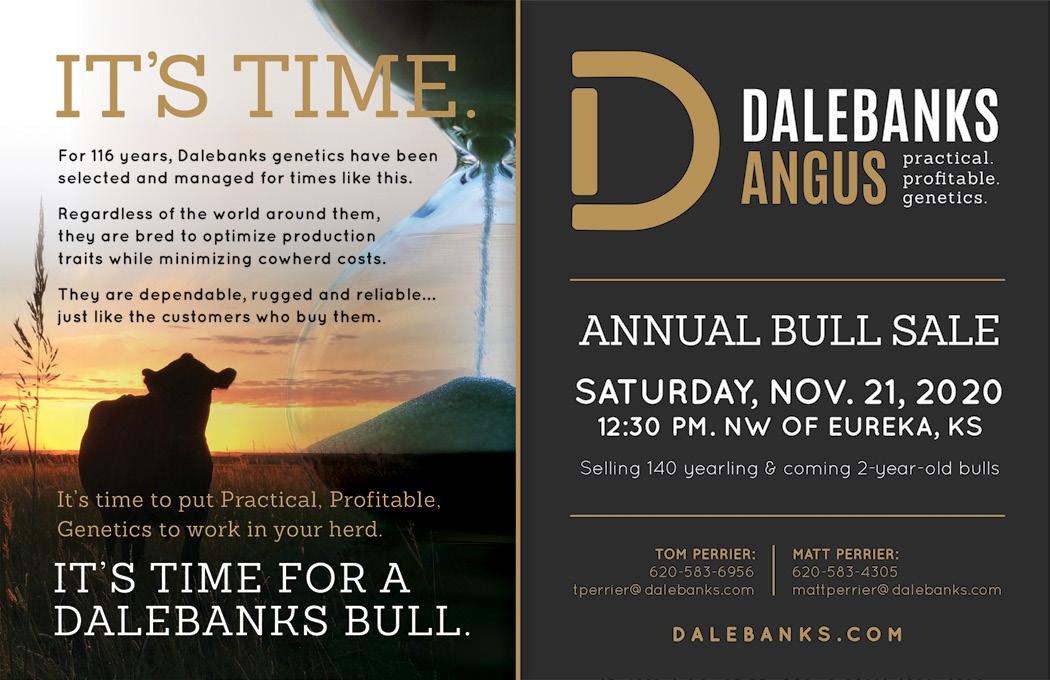
The Show Must Go On! 2020 MSF Angus Steer Carcass Contest Looks a Little Different
Source: The Word is Out - Brenda Black Photo Credit to Pearl’s Pics.
With no Missouri State Fair (MSF) On-Foot Carcass Show or Carcass Contest, youth exhibitors were left with finished livestock and no end point for their steer projects. But, Missouri Junior Angus steer exhibitors had an advocate who arranged for an outlet.
Samuel Jordan, Savannah, Mo., exhibits the Grand Champion 4-H Angus Market Steer at the 2020 Missouri State Fair Youth Livestock Show. “Since there was no on-foot carcass show, I recruited steers from the 4-H and the FFA show before and during the fair,” said David Warfield, Butler, Missouri. “And I only wanted 4-H and FFA Angus steers.”

The list of youth Angus Market Steer contenders at the 2020 MSF Youth Livestock Show included Lane Bollinger, Grace Bush, Hannah Epple, Sean Houston, Samuel Jordan, Clara Warfield and Luke Warfield. On Aug. 18, 2020, Chris Mullinix, Kansas State University Animal Sciences Instructor and head Livestock Judging Team Coach, evaluated the 4-H and FFA Angus steers.
Jordan, from Savannah, Mo., and representing Andrew County, took top honors and earned $300.00 for his Champion 4-H Steer. Clara Warfield of Butler, Mo., in Bates County garnered the Reserve title and won $200 for her 4-H steer.
In the FFA Steer Show, the Championship went to Houston of Savannah, Mo., who received $300. Bush from St. James, Mo., stood in the Reserve Champion slot with her Angus calf who earned her $200.
To Advertise in Missouri Beef Cattleman magazine or Prime Cuts e-newsletter Please Contact: Andy Atzenweiler

Phone 816-210-7713 E-mail: mobeef@sbcglobal.net Rates are available online at mocattle.com under the publications tab. Magazine deadline is the 15th of the month before an issue.
Clara Warfield, Butler, Mo., wins Reserve Champion Angus in the 4-H Market Steer at the 2020 Missouri State Fair Youth Livestock Show, and secures Grand Champion Angus Carcass with her 1,391 pound steer, who dressed at 817 pounds, graded Low Prime with a YG of 2.9 and REA 13.5.
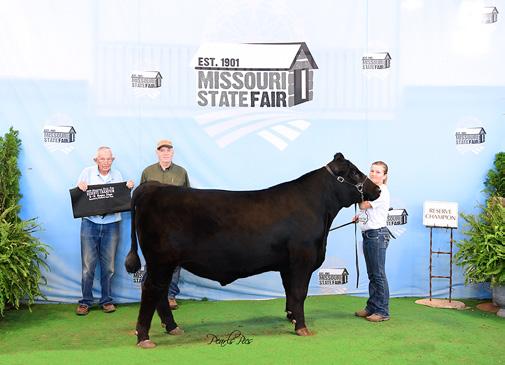
Sean Houston of Savannah, Mo., wins the Grand Champion Angus in the FFA Market Steer Show at the 2020 Missouri State Fair Youth Livestock Show. Sean exhibited a 1,365 pound steer, that ultimately dressed at 64%.
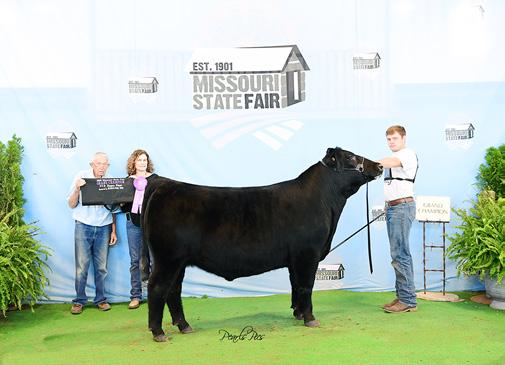
In order for a subsequent carcass contest to take place, David Warfield reached out to Creekstone Farms Premium Beef, LLC. During the pandemic, meat lockers in general were overrun with additional slaughter requests, creating a backlog of booking dates through next spring. Creekstone worked with Warfield to accommodate the immediate need. Warfield volunteered to truck the steers to Creekstone’s facility in Arkansas, Ks. On the way, he picked up another calf from a junior Angus member so that his steer could be included in the contest. A total of six steers were individually tagged and killed Aug. 20, with carcass data compiled.
Missouri Angus Association (MAA) General Manager Julie Conover separately assessed the carcass data, declaring Champion Angus Carcass as Clara Warfield’s 1,390 pound steer, who dressed at 817 pounds, graded
Grace Busch of St. James, takes Reserve Champion Angus in the FFA Market Steer Show at the 2020 Missouri State Fair Youth Livestock Show and was the only exhibitor to take two steers to Creekstone for the carcass contest.
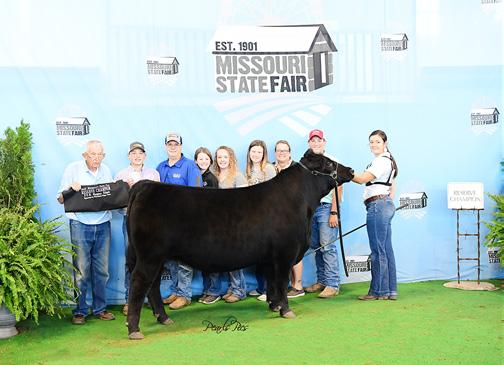
Low Prime with a YG of 2.9 and REA 13.5. Clara received $500 in prize money and a Quality Premium of $122.55, more than $100 over all other contenders as a result of grading Prime. Payton Frank of Wentzville, Mo., took home the Reserve Champion title and $300 for his 1,210 pound steer that dressed at 744 pounds and graded High Choice with YG 2.6 and REA 13.72.
Dr. Curtis Long of Briarwood Angus Farms, Butler, Mo., instituted the Angus Carcass Contest over two decades ago, and annually provides prize money through the MAA Foundation. Dr. Long was on hand to award embroidered championship garment bags to the top 4-H and FFA exhibitors during the live show. Participants will subsequently receive their monetary awards from Dr. Long and the MAA during the 2021 Annual Banquet in February.
Four participants who competed in both the Carcass and 4-H or FFA shows will additionally receive $200 Participation Awards. They are: Bush, Houston, Clara Warfield, and Luke Warfield.
For more information about the annual State Fair Carcass Contest, visit https://www.mostatefair.com/ or contact Briarwood Farms at 660-679-3459. And to learn more about the Missouri Junior Angus program, go to http://www.missouriangus.org/
New Location: Margaritaville Lake Resort

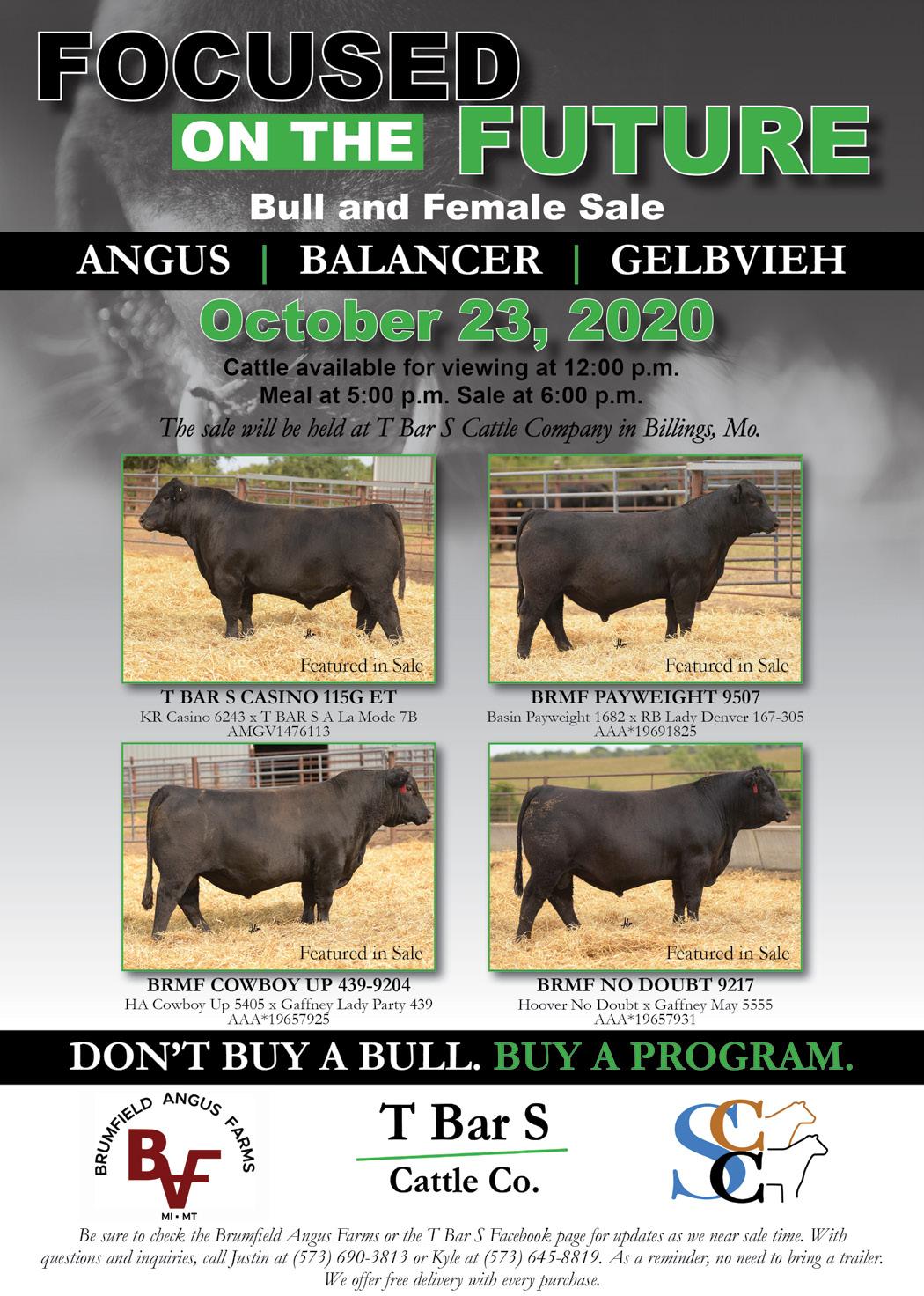



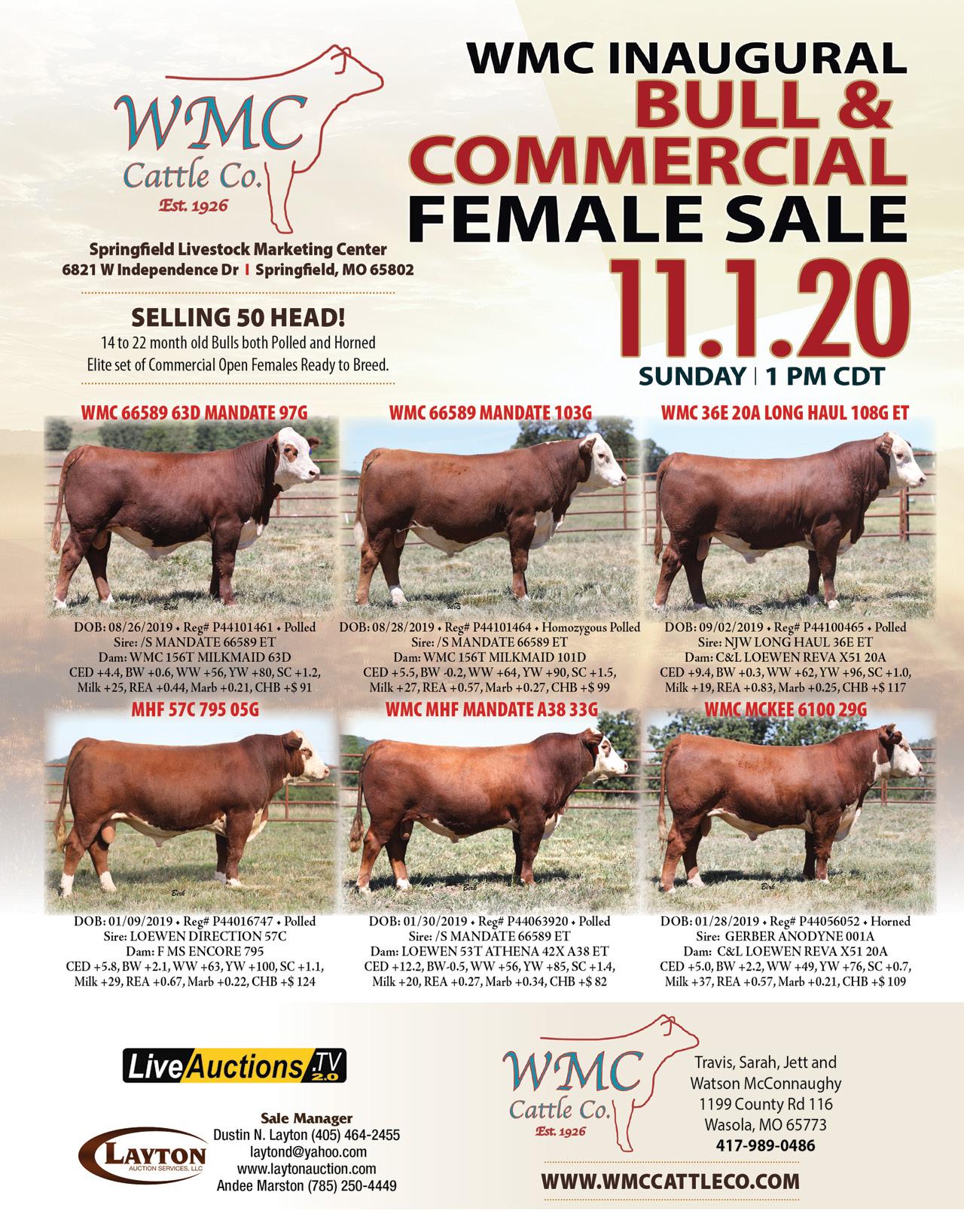
Source: ABS
ABS Global is pleased to welcome Jared Wareham as the North America NuEra Business Development Manager on September 21. In his new role, Wareham will grow the NuEra Genetics™ program as part of a whole-herd genetic solution for commercial beef customers. His role will focus on sales of NuEra genetics and expanding the existing NuEra Connect Program to support calf marketing opportunities for ABS customers.
The goal of the NuEra Genetics program is to deliver genetics that are more profitable across the beef supply chain. As part of a whole herd genetic solution, including an AI program, NuEra Genetics are designed to meet customer needs by creating a calf that is more valuable at marketing. “I am truly humbled each time I stop to consider the scope and scale of what our entire industry strives to do each day, which is to feed people. We love and embrace a lifestyle rooted in production and service, doing our best to raise the next generation of agriculturalists along the way,” Wareham says. “The opportunity to do my part by delivering precision genetic solutions to each segment of the beef value chain and pioneer improvement is an honor.”
“ABS has always led with innovation and we are excited to have Wareham on board and leveraging his extensive beef industry experience to drive the NuEra Genetics program to make our customers more profitable,” says ABS Global Beef Product Development Director, Matthew Cleveland.
Wareham comes to ABS after serving as General Manager of Top Dollar Angus, a company that utilizes third-party genetic verification to remove risk and add precision to cattle procurement. He spent much of his time working with ranches and feedyards across the US linking them together through genetic assisted buying and selling. Wareham has more than two decades of experience in the livestock industry, along with Bachelor’s and Master’s degrees from the University of Central Missouri. Wareham brings considerable knowledge in growing genetics-based companies that serve producers from the ranch to the packer.
Wareham also enjoys writing thought-provoking pieces about the beef industry for Farm Journal Media with his “New Generation” column that appears in Drovers Magazine. In his spare time, Wareham with his wife Jill, and their three daughters, manage a 100 head cow/calf operation in west central Missouri.


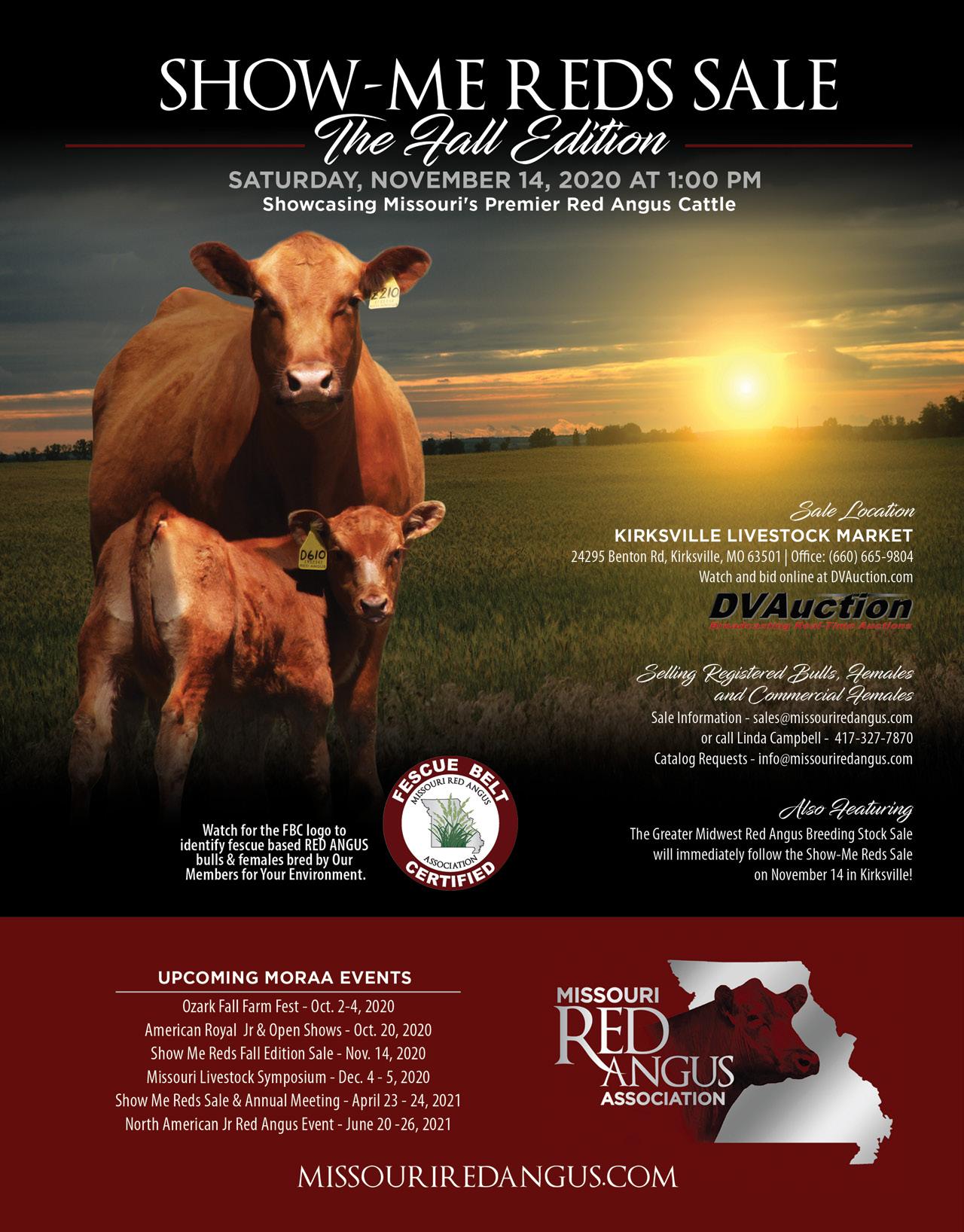
July Beef and Pork Exports Rebound, but Still Below Year-Ago
Source: USMEF
July exports of U.S. beef rebounded from recent lows but remained below 2019 levels, according to data released by USDA and compiled by the U.S. Meat Export Federation (USMEF). U.S. pork exports, which are on a record pace in 2020, were also down from a year ago in July but increased compared to June. July lamb exports increased year-over-year and were the largest of 2020.
“With production returning to near-normal levels, we definitely saw an improvement in beef exports, though the recovery was not quite as strong as expected,” said USMEF President and CEO Dan Halstrom. “China’s pork demand has moderated and we are also entering a time when year-over-year gains are not nearly as dramatic, as exports to China began gaining momentum in mid-2019. But pork exports to Mexico showed encouraging signs of recovery in July and we also saw promising growth in several emerging markets, including Vietnam and the Philippines.
“It is also important to remember that the monthly export data is in the rear-view mirror and that weekly export sales data, along with observations from our USMEF-China team, suggest that China’s demand for both U.S. pork and beef will be strong through the balance of the year, including purchases for Chinese New Year. When combined with the rebound in other main markets, growth in emerging markets and the return of the U.S. supply advantage, USMEF remains optimistic about a strong finish for U.S. red meat exports in 2020, despite many challenges related to COVID-19.”
July beef exports totaled 107,298 metric tons (mt), up 36% from June but still 9% below last year. Export value was $647.8 million, the highest since March but down 10% from a year ago. July exports to China increased sharply year-over-year and shipments trended higher to Taiwan, Canada and Hong Kong. July exports were lower than a year ago to Japan and South Korea and declined significantly to Mexico. For January through July, beef exports were also 9% below last year’s pace in volume (698,907 mt) and 10% lower in value ($4.28 billion).
July pork exports totaled 222,035 mt, down 5% from a year ago, while export value fell 12% to $548.3 million. Exports increased year-over-year to China/Hong Kong, Canada, the Philippines, Vietnam and the Caribbean. Exports to Mexico remained below last year but were the largest since March, while shipments to Japan were also down from a year ago but the largest since April. For January through July, pork exports remained 20% ahead of last year’s record pace in volume (1.78 million mt) and 22% higher in value ($4.6 billion).
With Mexico as the main driver, July exports of U.S. lamb exports posted the largest monthly totals of the year in both volume (3,547 mt, up 115% from a year ago) and value ($3.5 million, up 46%). July exports also trended higher to Bermuda and Canada. Through July, lamb exports were 20% higher than a year ago at 11,299 mt, but export value ($13.9 million) still trailed last year by 11%.
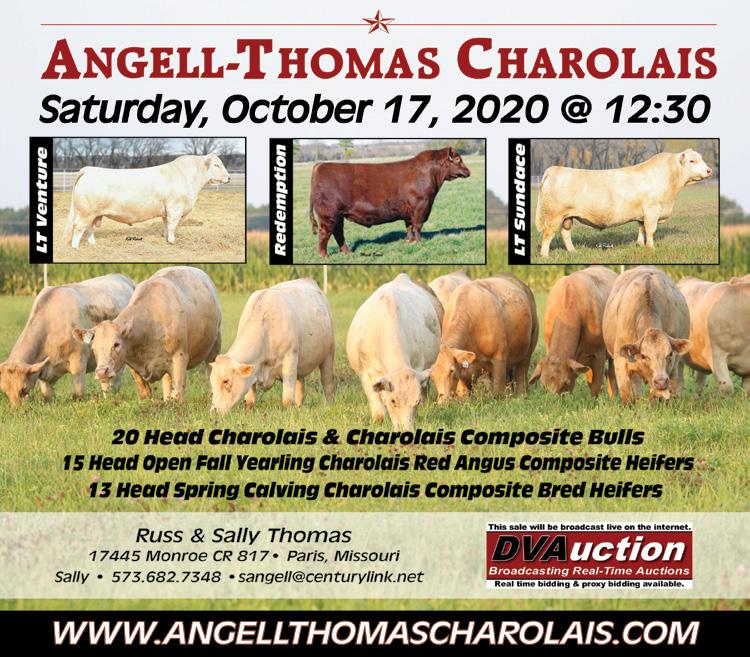
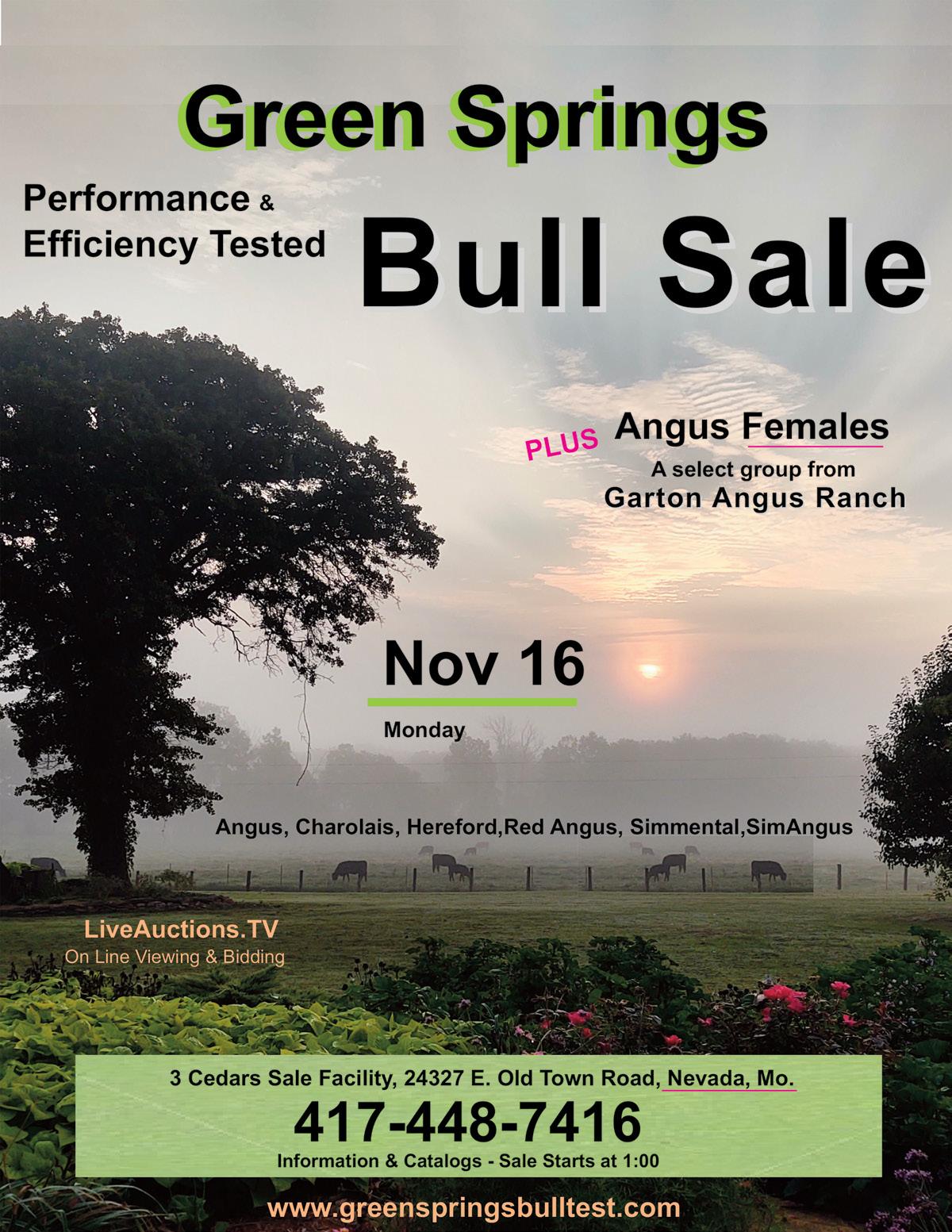
Derrell Peel: Producers have Opportunities to Maximize Returns
Source: BioZyme
(SAINT JOSEPH, Mo., Sept. 3, 2020) The cattle business is filled with risks. However, for all the uncertainty there are an ample amount of opportunities available for those producers who manage their risks and plan accordingly. With so many external influencers in the cattle market such as the environment, the recession and a pandemic, it might seem daunting to plan for the future.
Forecasting the future to gain as much profit as possible takes many factors. With some astute advice from an industry expert and scholar of the markets, producers can try to achieve the profit they are seeking.
Derrell Peel, Oklahoma State University Extension Livestock Marketing Specialist, suggests numerous opportunities for cow-calf producers exist, especially as the markets have steadily climbed out of their slump in July and early August. He adds the futures markets are looking good, and with proper planning and reasonable input costs, producers are likely to turn a profit.
“We always have some idea based on where the market is at this point and frankly, I’ve been pretty impressed in the last few weeks with the way these markets have improved. We have a consistent signal across the industry right now, which is very good. When you don’t have that you know something is going to change; something is going to give. The outlook for the markets has improved somewhat in the second half of the year. That said, there are a tremendous amount of uncertainties out there. There’s a range of things that could improve or go the other way,” Peel responded when asked to forecast the fall market.
Peel offers three considerations to the cow-calf producer to maximize the profit on their herd this fall. However, before any action is taken, the producer needs to know his or her budget. What are the expenses of the operation? How much does it take to run a cow in a given year? What resources are available? Will you need to buy additional resources before the next calf arrives?

Drought Management
In parts of the Midwest where drought has been an issue, early weaning is a good option to stretch feed resources. There are both advantages to the cow and the calf, from a nutritional standpoint. Peel explains.
“Early weaning is actually one of the first things I would think about because pulling those calves off of the cow reduces her nutritional requirements dramatically. What forage supplies you do have left at that standpoint can go a lot further for the cow by simply removing the calf,” he said.
Once the calves are weaned, opportunities exist for some decision making for both the cows and the calves to help increase profits. A producer can better make separate decisions for the cows and the calves post-weaning.
Peel said that cull cow prices have been good and will remain positive for a while. He suggests that if you’ve weaned already to sell any cull cows now instead of waiting until later, as the cow market typically hits a seasonal low in late fall.
Culling decisions should start with preg checking cows. Then, cull on any physical attributes that might be detrimental to the herd like mouths, feet and udders. Follow the hierarchy of culling factors that includes open cows, older cows and the need to keep replacement heifers.
“If you pull calves off now because forage resources are low, it makes sense to do some early culling. Preg check now instead of waiting and use those same factors that would drive culling decisions now in late August or September instead of early November. Producers have the opportunity to improve
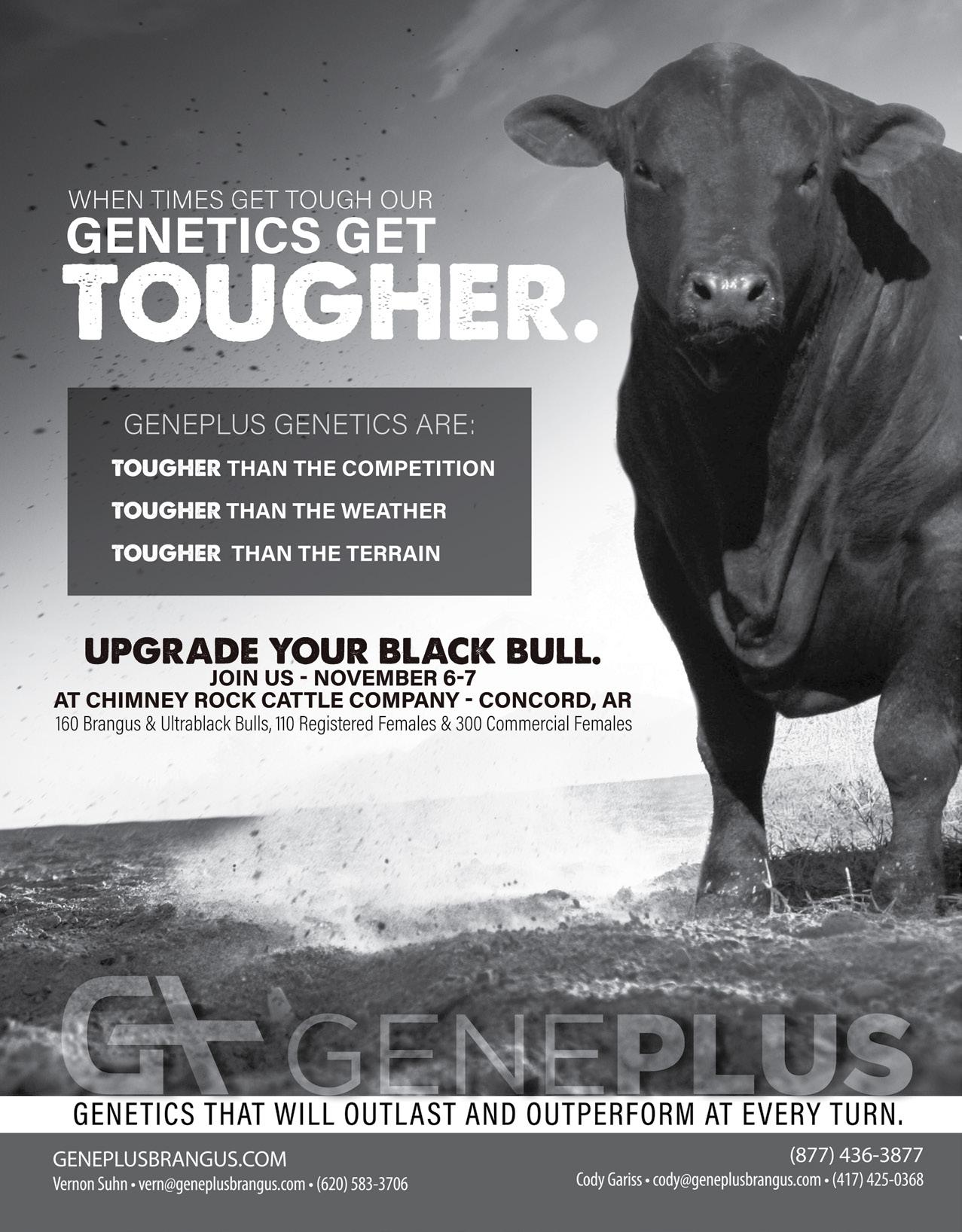
Decisions about what to do with your calves might take some more planning and following of the markets. Although the markets are steady, and a producer could benefit from selling calves now, according to the futures, there is some potential for further economic gains through retained ownership, even if that entails only a short backgrounding session.
Retain Ownership
Retaining ownership of calves for a while could lead to some potential increased profits depending on how long you want to feed them and what your resource inventory looks like. If you background them even until they are “normal” weaning weights, you will likely feed them in grain in a confinement or semi-confinement situation, according to Peel, so you will you need adequate grain and feed sources.
“Evaluate retained ownership or decide to sell now – short backgrounding could pay off. The markets look pretty positive; the futures are strong right now so here’s an opportunity to do some risk management. Using the futures as an indicator of where markets might end up – regardless if it is this fall of the first quarter of next year, there are lots of opportunities to manage risk,” Peel said.
The combination of a positive outlook on cattle prices and the availability of feed makes retaining ownership through heavier weights more appealing than selling now; however, there is always risk. Grain is fairly inexpensive, and there is a big corn crop this year with plenty of supplemental feeds available.
Even with the hurricane-force winds that took down thousands of acres of corn across Iowa and northern Illinois, that damage will have a local impact rather than a global impact on grain prices. And producers should still have the chance to graze some of those fields that are too downed to harvest in traditional ways. In addition to grazing stalks – both harvested and not harvested, grazing wheat through the plains states is another alternative that Peel says looks like a great alternative to help increase profitability.
Grazing Wheat
With adequate rainfall and moderate temperatures through much of the Wheat Belt, those who want to maximize grazing will start planting wheat by the first week in September. However, hot, dry and windy conditions could be detrimental to any hopes of good wheat pasture.
“Physical conditions are good now for planting wheat for forage. We’ve had quite a bit of rain in Central Oklahoma, but even far Western Oklahoma has had some improvement. Calf prices might go up between now and October, when we’d typically start grazing wheat, if we don’t buy until October. But even then, the futures indicate there is some potential for profit when selling those calves next spring,” Peel said.
Of course, he indicated that producers have to consider if they are raising wheat for purely grazing or for the dual purpose of grazing and grain production. Early planting can lead to challenges like army worms, however, if using for a forage, the benefits will usually outweigh the challenges.
“There are still risks with pandemic, potential problems in meat markets,” Peel said. “There is plenty of risk out there, but plenty of reasons to evaluate opportunities.”
Producers should take the time to manage their risks to help maximize their returns. In an era of uncertainty, increasing profitability in your business is a sure bet that everyone can agree on. Know your budget. Calculate your breakeven and manage your herd and follow the best considerations to help you see the most return on your investment.
Scott Cape, Owner of Jim’s Motors in Cuba, Missouri. All I have ever done is sell and trade trailers. Give me a call for your next trailer 800-897-9840 www.Jimsmotors.com
Custom Cattle Feeding • 12,000 Head Capacity
Family owned & operated since 1917
Steve Sellers 620-257-2611 Kevin Dwyer 620-680-0404

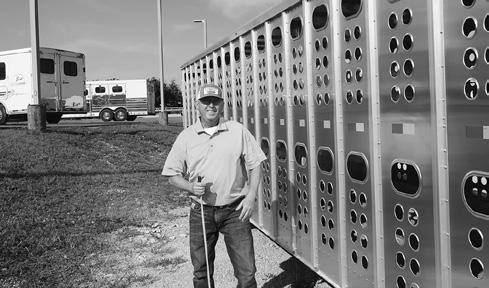
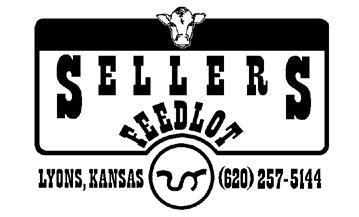
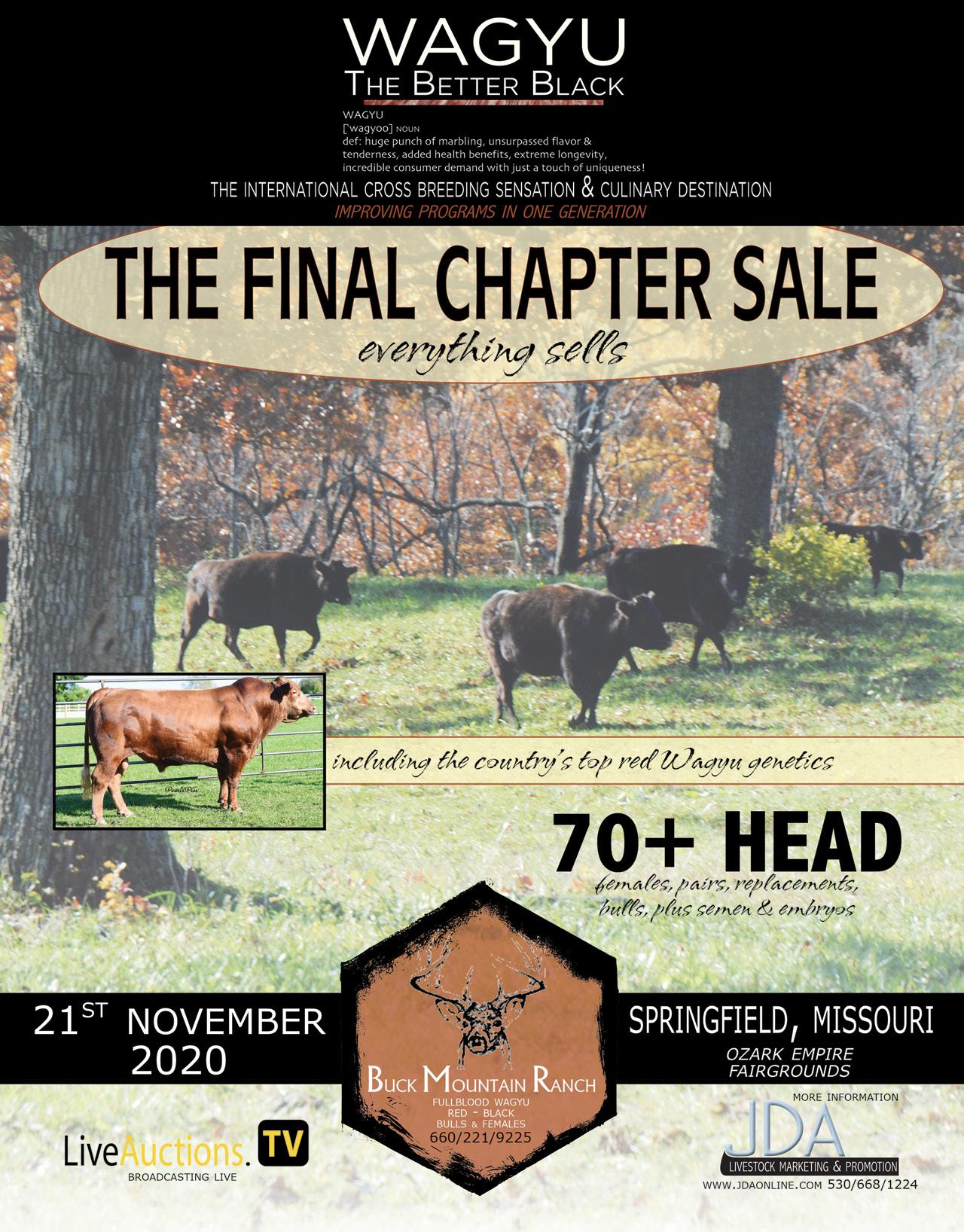
Source: The Word is Out - Brenda Black
Briarwood Angus Farms welcomed Governor Mike Parson and First Lady Teresa Parson on Saturday, August 29. Rainy weather couldn’t dampen the enthusiastic crowd that gathered by special invitation to enjoy a steak and lend their support for the Governor’s campaign. Gov. Parson arrived with his trademark wide grin. In opening remarks, he expressed considerable gratitude for being among “my kind of people.” Dr. Curtis W. Long welcomed his fellow cattleman, esteeming him as “The best governor ever of Missouri!” In a show of support, Long presented a check to Gov. Parson on behalf of the family and employees of Briarwood Angus Farms. In addition to the funds raised by those in attendance, the governor also graciously received a campaign contribution from Missouri Cattleman’s Association, presented by MCA Manager of Membership Sydney Thummel, accompanied by the Bates County Cattlemen officer team of Ryan Grimes, President; Austin Black, Vice President; Dave Warfield, Treasurer; Jesse Porter, Secretary/Reporter; Carl Bettles and Lonny Duckworth, State Directors; and Susie Hockett, Bates County CattleWomen President, who represented the membership at large. “What started as a brief trip turned into an event that raised around $6,000 for our governor,” Thummel said. Parson’s personal and impassioned farm site chat recapped the roller coaster year of 2020, including record breaking lows for unemployment prior to the pandemic, and unprecedented challenges in the midst of the crisis. He went on to emphasize the importance of rural voters to inform their friends, neighbors and urban acquaintances of his extensive and transparent track record in public service. Closing comments focused on a somber appeal to vote in such a way as to preserve a free republic for the sake of our state’s and our nation’s
MBCSept2014c.qxp_Layout 1 9/24/14 9:59 AM Page 62
children.
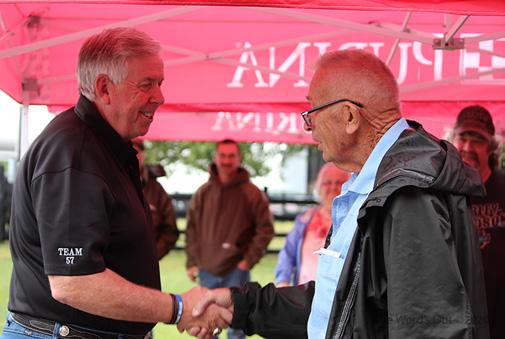
Gov. Mike Parson flashes his signature smile upon arrival to Briarwood Angus Farms, Butler, Mo., for a fundraising luncheon.
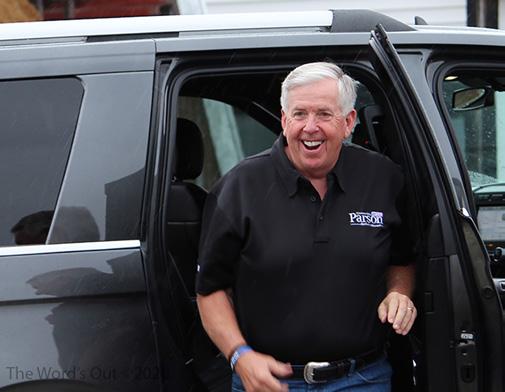
Buffalo Livestock Market 1milewestonHwy32•Buffalo,MO65622 Barn:417-345-8122
Sale Every Saturday 12:00 Noon •Selling1200to1700headFarmFreshCattleweekly •SpecialStockCowandBullSale 3rdTuesdaynightofeachmonthat6:30p.m. •Pre-VacFeederCalfSales2ndSaturdayofeverymonthin conjunctionwithRegularSale(PfizerPre-Vac,BLMPre-Vac, BayerProgram,MoQualityAssurance.LMA-Vacand MFAHealthTrack) Order Buying Service Available Owners… LyleCaselman LeonCaselman HowardMiller 417-345-7876H 417-345-4514H 417-345-8612H 417-533-2944cell 417-588-6185cell
Dr. Curtis W. Long welcomes Gov. Mike Parson to Briarwood Angus Farms.
Missouri Cattlemen’s Association Manger of Membership Sydney Thummel presents a contribution on behalf of the MCA to Governor Parson. L-R: MCA members Austin Black, Jesse Porter, Dr. Curtis W. Long, Sydney Thummel, Gov. Mike Parson, Lonny Duckworth and David Warfield.
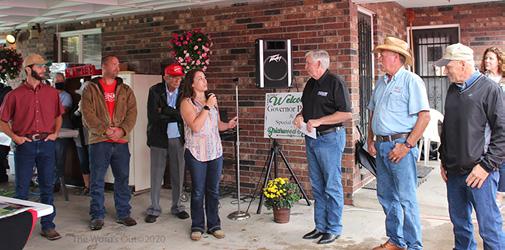
The Parsons lingered casually, taking time to visit one on one with constituents, before heading out for three more campaign stops that day.
The governor’s appearance at stop number one at Briarwood came as a result of Long’s purchase of an MCA Pac Auction item during the 17th Annual Cattlemen’s Steak Fry in July. Along with the massive campaign sign purchased, which will be placed on Briarwood’s highway front property in Bates County, Gov. Parson committed to the farm visit.
Guests for the event enjoyed steak sandwiches prepared by the Bates County Cattlemen and served by the Bates County CattleWomen. Other sponsors included Heiman Agri Service at Rockville, and Purina® .
Joining Gov. Parson in securing a campaign banner are Bates County Cattlemen Past President Ivan Fischer, President Ryan Grimes, MCA State Director Carl Bettles and Dr. Curtis W. Long, who placed the highest bid for the campaign sign along and governor’s visit during the MCA PAC Auction in July. Gov. Mike Parson and First Lady Teresa Parson are joined by the Bates County Cattlemen Officers L-R: Jesse Porter, Secretary/Reporter; State Director, Carl Bettles; President, Mike Grimes; First Lady Teresa Parson; Gov. Mike Parson, Vice President Austin Black, Bates County CattleWomen President Susie Hockett; State Director Lonny Duckworth, Treasurer, David Warfield and Junior Bates County Cattlemen member Luke Warfield.
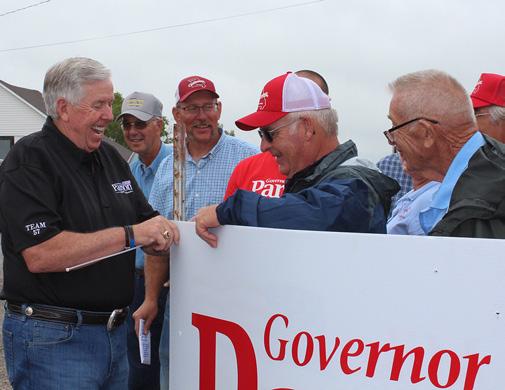
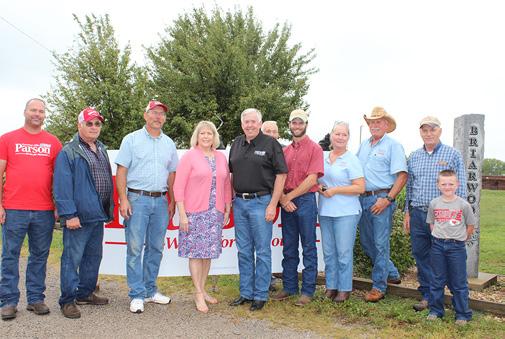
JAYLOR 5 SERIES MIXERS. IN STOCK AND READY FOR THE FARM

OVERSTOCK Sale Going on NOW
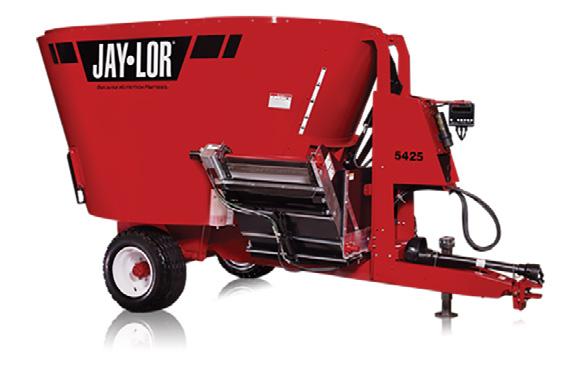
www.JAYLOR.com






